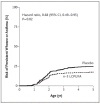Can Early Omega-3 Fatty Acid Exposure Reduce Risk of Childhood Allergic Disease?
- PMID: 28754005
- PMCID: PMC5537898
- DOI: 10.3390/nu9070784
Can Early Omega-3 Fatty Acid Exposure Reduce Risk of Childhood Allergic Disease?
Abstract
A causal link between increased intake of omega-6 (n-6) polyunsaturated fatty acids (PUFAs) and increased incidence of allergic disease has been suggested. This is supported by biologically plausible mechanisms, related to the roles of eicosanoid mediators produced from the n-6 PUFA arachidonic acid. Fish and fish oils are sources of long chain omega-3 (n-3) PUFAs. These fatty acids act to oppose the actions of n-6 PUFAs particularly with regard to eicosanoid synthesis. Thus, n-3 PUFAs may protect against allergic sensitisation and allergic manifestations. Epidemiological studies investigating the association between maternal fish intake during pregnancy and allergic outcomes in infants/children of those pregnancies suggest protective associations, but the findings are inconsistent. Fish oil provision to pregnant women is associated with immunologic changes in cord blood. Studies performed to date indicate that provision of fish oil during pregnancy may reduce sensitisation to common food allergens and reduce prevalence and severity of atopic eczema in the first year of life, with a possible persistence until adolescence. A recent study reported that fish oil consumption in pregnancy reduces persistent wheeze and asthma in the offspring at ages 3 to 5 years. Eating oily fish or fish oil supplementation in pregnancy may be a strategy to prevent infant and childhood allergic disease.
Keywords: allergy; asthma; early life origins; eczema; eicosanoid; inflammation; omega-3; omega-6; polyunsaturated fatty acid; resolution.
Conflict of interest statement
P.C.C. is an advisor to DSM, Danone/Nutricia, Friesland Campina and Cargill and has received speaking honoraria from DSM, Danone and Abbott Nutrition. E.A.M. has no conflicts to declare.
Figures





References
-
- Jackson A.A. Nutrients, growth, and the development of programmed metabolic function. Adv. Exp. Med. Biol. 2000;478:41–55. - PubMed
Publication types
MeSH terms
Substances
LinkOut - more resources
Full Text Sources
Other Literature Sources
Medical

